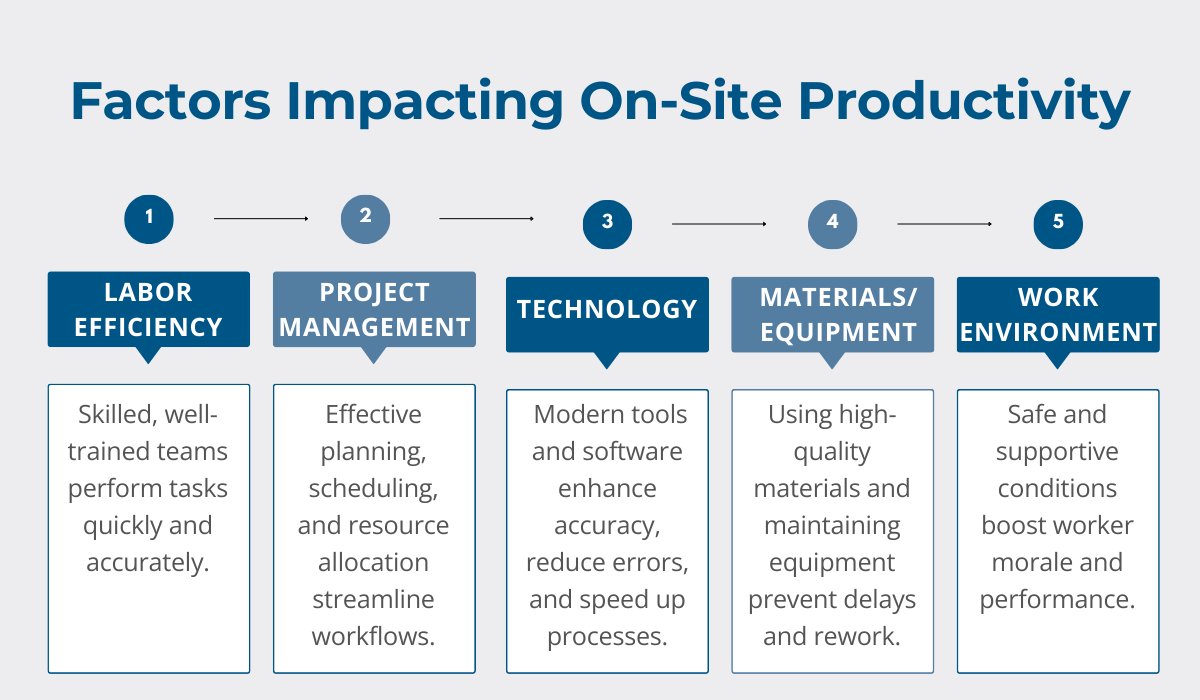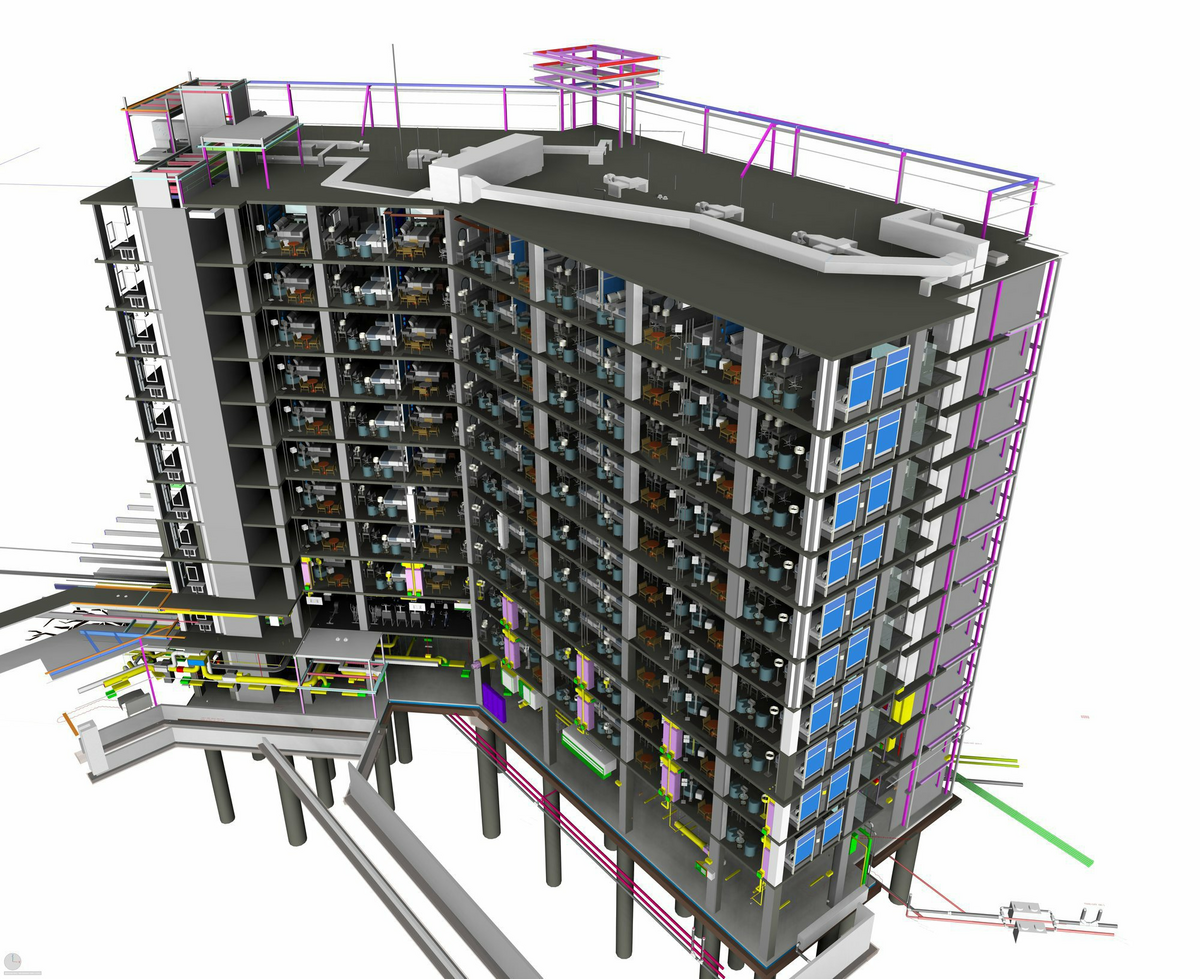Key Takeaways:
- Construction is lagging behind other industries when it comes to productivity.
- Contractors lose up to 90 hours per month on asset tracking, which hinders their productivity.
- Adopting technology like asset tracking software and BIM is key to boosting construction productivity.
Productivity, in a broad sense, refers to the efficiency with which inputs (labor, materials, and equipment) are converted into outputs (completed tasks, finished projects).
Specifically, in the construction industry, productivity often focuses on labor productivity, which measures the amount of work completed during work hours.
So, whether it’s laying bricks or ordering materials, the key is to do it quickly and with high quality.
And, as a construction professional, you know that in this industry, time equals money.
That’s why boosting productivity isn’t just a nice to have.
It’s essential for staying competitive and profitable, ensuring that projects are completed on time and within budget.
This guide will help you understand what productivity means in construction, how to measure it, why you should aim to increase it, and which tools can help you achieve higher productivity levels faster.
Let’s dive in.
In this article...
Construction Productivity Explained
As a construction professional, you understand the critical role productivity plays in the industry.
Productivity measures how efficiently you use labor and resources to complete projects.
High productivity means getting more done with less effort and fewer resources, which leads to cost savings and timely project completion.
Several factors directly impact your productivity on site, as outlined in the image below.

However, despite your best efforts, productivity in construction has often lagged behind other industries.
From 1990 to 2017, construction labor productivity increased by just 1% per year on average, compared to 2.8% for the global economy and 3.6% in manufacturing, according to the McKinsey Global Institute.
If the sector caught up with the global economy’s average productivity, it could add $1.6 trillion to the industry annually.
So, what’s holding you back?
Labor and skill shortages, poor project planning, communication breakdowns, and slow adoption of technology are key challenges.
But here’s the good news: change is happening.
In 2018, more than half of construction professionals recognized the impact of technology on productivity and planned to invest in tools to improve it.

Fast forward to 2024, and the trend continues.
According to a recent Deloitte report, increased productivity is among the top five benefits of adopting new tech in construction.
Companies are embracing a broad range of technologies, including artificial intelligence (AI), data analytics, and cloud management software.
However, they still face hurdles, with 42% of businesses citing digital skills gaps and 34% reporting budget constraints for new technologies.
Despite these challenges, companies that invest in new technologies are seeing strong returns:
- 1.4% higher revenue growth,
- 1% higher profit growth, and
- more projects delivered on time and under budget.
These are the real benefits of increased productivity, and construction companies are on the right path to achieving them.
By focusing on efficiency, leveraging technology, and fostering a supportive work environment, you too can boost your productivity and stay competitive.
Benefits of Increasing Your Productivity
Better cost management, higher profits, and more savings, as well as projects finished on time and within budget, are the biggest benefits of increased productivity in your construction operations.
Let’s dive into each and how you can achieve it.
Better Project Cost Management
Let’s face it: managing costs is probably one of the biggest challenges you deal with.
Labor and materials are expensive, and overruns can eat into your profits.
But increasing productivity can be your solution.
By boosting productivity, you streamline work processes, which leads to fewer wasted materials and less time spent on rework.
This results in lower overall project costs and better profitability for you.
Here’s how you can achieve better cost management:
- Plan, schedule, and track progress to minimize downtime and waste.
- Reduce the need for repairs and replacements by using high-quality materials.
- Train your team well to perform tasks efficiently and correctly the first time.
Meeting Project Deadlines
Furthermore, high productivity is the key to maintaining a strong reputation for delivering projects on time.
On the other hand, delays can lead to penalties, dissatisfied clients, and a damaged reputation.
In fact, according to a survey by the Association of Professional Builders, nearly two-thirds of builders do deliver projects on time (63.5%), so if you want to stay in the competition, you must do the same.
What’s more, by ensuring your team stays on schedule and completes tasks faster, you become the preferred contractor for clients who value timely project completion.
Here’s how to meet deadlines consistently:
- Use advanced scheduling tools to allocate tasks and resources efficiently.
- Track project progress in real time to identify and address delays immediately.
- Have contingency plans in place to mitigate potential delays.
Outperforming Competitors
In a competitive construction market, what is it that can set you apart?
We believe it is the ability to deliver high-quality projects quickly and within budget.
When productivity is high, you can offer more competitive pricing while maintaining healthy profit margins.
This, in turn, attracts more clients and differentiates you from competitors struggling with inefficiencies.
Here’s how to increase productivity to outperform competitors:
- Implement tools like Building Information Modeling (BIM), drones, and asset tracking software to streamline operations.
- Use data analytics to better understand and manage resource allocation.
- Regularly review and refine processes to eliminate bottlenecks and improve efficiency.
Simply put, increasing productivity leads to more efficient and successful projects, improved profitability, and enhanced industry reputation.
So, embrace these benefits and prioritize productivity improvement in your company.
But before you do, you need to know how to measure it effectively.
How to Measure Construction Productivity
Understanding how to measure productivity in construction is crucial for effective project management.
Why?
Because it allows you to identify areas of improvement and make informed decisions.
So, how can you accurately measure productivity on your job sites?
You can start by tracking these three metrics:
Labor Productivity
Track the total hours worked by each worker or crew, and quantify the amount of work completed (e.g., square feet of drywall installed).
Calculate the productivity rate by dividing the output by the total labor hours.
For example, if a team installs 1,000 square feet of drywall in 40 hours, the labor productivity is 25 square feet per hour.
Equipment Productivity
Record the hours each piece of equipment is in operation and quantify the work done by the equipment (e.g., cubic yards of earth moved).
Calculate the productivity rate by dividing the output by the equipment hours.
For instance, if a bulldozer moves 2,000 cubic yards of soil in 50 hours, its productivity is 40 cubic yards per hour.
Resource Productivity
Combine all resources used (labor hours, materials, equipment hours) and compare it to the total work completed.
Let’s say a project requires 200 labor hours, 500 tons of materials, and 100 equipment hours to complete 1,000 units of work.
The resource productivity would then be 5 units per combined resource hour.
Once you have this data, you can use it to improve productivity in several ways:
- Compare your crew’s performance against industry standards or past projects to identify areas for improvement.
- Use the data to pinpoint and address inefficiencies in your processes.
- Establish achievable goals based on your productivity data.
- Ensure that resources are used effectively and efficiently.
- Conduct regular reviews with your team to discuss performance and areas for improvement.
All in all, when you accurately measure productivity through these metrics and take steps to improve it, you can achieve better project outcomes and increase profitability in your construction projects.
Tools for Improving Construction Productivity
Leveraging the right tools can significantly enhance your productivity levels.
This is a fact recognized not only by construction experts but also across various industries.
Without technology, construction sites can lag behind, as Anirban Basu, CEO of Sage Policy Group, explains:
“The typical construction site in America still looks much as it did five decades ago with one person managing a piece of heavy equipment while five others wait for the next step. Technology combined with a shift in processes is fundamental to boosting productivity and achieving greater coordination, consistency, and efficiency across different tasks.”
As Basu points out, technology and a shift in processes are key to moving away from this and gaining productivity.
Furthermore, according to InEight, investing in technology offers substantial benefits, with higher productivity and better risk management being the top advantages.
This is closely followed by organizational efficiency and cost savings.
So, what are the tools that can transform your construction productivity?
Let’s explore some options.
Project Management Software
This technology is invaluable for planning, scheduling, and tracking progress.
Project management software provides a centralized hub for all project details, ensuring everyone involved stays informed and aligned.

You can assign tasks, set deadlines, monitor progress, and manage documents—all from one place.
This streamlines communication, reduces miscommunications, and keeps your projects running smoothly.
As poor communication is the biggest culprit for rework—one of the biggest productivity disablers—investing in a tool that improves communication is crucial.
Asset Tracking Software
Michael McGowan, region head and CEO of Hilti North America, highlights the significant productivity loss due to ineffective asset management:
“Our research shows that each jobsite loses on average one day per month of productivity due to workers searching for tools. In addition, the contractors end up spending up to 90 hours per month tracking tools: in essence, productivity loss for both workers and contractors due to lack of an effective asset/tool management platform.”
So, you need the right tool that will help you track tools and other assets and give you back those 90 hours.
Our very own asset tracking software, GoCodes, might just be the perfect solution.
GoCodes improves construction productivity by providing real-time location tracking and maintenance scheduling, ensuring efficient use and upkeep of equipment and tools.
This reduces downtime due to equipment loss or breakdowns and enhances resource management, leading to smoother project execution and cost savings.
The software comes with a user-friendly app and QR-coded labels that can be attached to your assets.

With just one dashboard, you can monitor asset location, schedule maintenance, and assign tasks.
All this streamlines your operations, improves efficiency on-site, and boosts productivity both in the office and on the construction site.
It’s a win-win.
Building Information Modeling (BIM)
Another technology that is highly necessary to increase construction productivity is definitively BIM software.
This tool helps you create and manage digital representations of buildings, facilitates better collaboration among stakeholders, reduces errors, and improves efficiency of construction processes.

By visualizing the project before it’s built, you can identify potential issues early, save time and resources, and again, increase productivity.
Drones and Robotics
Technology like drones and robotics can also boost productivity.
For example, drones can conduct site surveys and inspections quickly and safely, providing detailed aerial views and data without extensive manual labor.

Robotics, on the other hand, assist in repetitive or dangerous tasks, increasing efficiency and reducing the risk of accidents.
For example, Shimizu Corporation in Japan uses robotic technology for tasks like welding and ceiling board installation.
This not only improves productivity but also addresses labor shortages, as Hiroki Ogura of Shimizu Corporation, points out:
“The rapid decline in skilled construction workers underscores the urgent need for enhancing productivity and adopting manpower-saving technology.”
Additionally, at Shimizu, they use 3D printing technology.
This offers significant advantages by enabling highly automated construction processes and enhancing flexibility in design and construction.
As you can see, there are many tools on the market that can boost productivity in construction.
By incorporating them into your projects, you can revolutionize productivity, streamline operations, and stay ahead in the competitive construction industry.
So, now is the high time to invest in them!
Conclusion
It’s undeniable: in the construction industry, maximizing productivity is the key to staying ahead and ensuring success.
By diving into the factors that affect productivity, adopting smart project management strategies, and harnessing cutting-edge tools like project management and asset tracking software, BIM, drones, and robotics, you can streamline your operations, slash costs, and consistently deliver projects on time and within budget.
With all these elements working together, you’ll supercharge your productivity and future-proof your business.
Now’s the moment to make productivity your top priority, embrace the latest tech innovations, and propel your construction projects to new heights.





